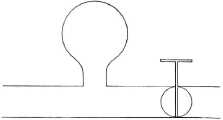1942 - 1947 CHEVROLET SHOP MANUAL
Section 12 - Electrical System
|
|
|||
|
12-24
|
|||
|
|
|||
 |
side of the condenser, which is grounded, equalizing
the two sides of the condenser. This is fundamentally the same
as when the counter air pressure
in the surge chamber of the water system, overcame
the surge pressure on the line. The surge chamber discharged and
forced the water back in the line equalizing the
pressure.
IGNITION DISTRIBUTOR
Since the spark must occur at a given instant
in the engine crankshaft rotation,
the switch must be operated
by the engine itself. This switch is
called the mechanical breaker,
timer or interrupter.
The breaker arm is pivoted at one end and carries
at its free end a contact which is held against
a similar contact by a spring
acting on the breaker arm.
The stationary contact is mounted on the
breaker plate to permit
adjustment of the points.
When the contact points are together and the ignition
switch is closed, current will flow through the breaker arm
contacts and primary winding of the
coil.
The cam is positively driven by the engine. As
it rotates, the lobes of the cam
strike the rubbing block
on the breaker arm, causing the arm to swing outward, thus
separating the contacts or points. This interrupts the current which
was flowing through the primary
winding of the coil, and produces a spark as previously described. As
the cam continues to turn, the lobe passes the rubbing block
and the spring pulls the breaker
arm back until the
contacts come together again. The current then
flows through the primary winding
of the coil and the
operation is repeated as before. The cam is not
only positively driven from the
engine, but it is also
"timed" to the engine so that it interrupts the
circuit through the coil at the
instant the spark is
required.
The mechanical breaker is made in this form in
order to open the primary circuit
quickly and to operate at
the highest speed.
AUTOMATIC SPARK CONTROL
The spark control is of the automatic type, that
is, the spark is automatically
advanced or retarded by two
methods. First, the vacuum spark control
gives quick advance to the spark,
to give power at low
engine speeds and when the throttle is
opened quickly the spark is
momentarily retarded,
preventing laboring of the engine and pinging, until the load is
relieved, at which time the spark is
automatically advanced. At higher
engine speeds, this vacuum spark control cuts out, retarding the
spark for better economy
and engine performance at
these higher speeds.
|
||
|
Fig. 52-High Pressure Water Line
In Fig. 52 we have a high pressure water line
with a valve located in the line.
Just ahead of the valve is
located an air chamber called a surge
chamber.
When the valve is opened, there is not a full
head of water, because it takes
some time to set a body of
water in motion. During this time energy is stored in this volume of
water, because of its speed
of movement. If the valve is suddenly closed
the pressure on the line plus the
momentum of the moving body
of water has to be stopped. This is
many times greater in pressure
than the normal line
pressure. The surge pressure forces the water
into the air chamber compressing
the air. The air then
offers a counter pressure which slows down the momentum of the
water. A moment later the air
pressure in the air chamber overcomes the surge
pressure in the line, and forces
the water back into the
line. This action absorbs the surge without
damage to the system.
The condenser in the ignition system, Fig. 51, acts in exactly the
same manner. When the ignition
switch is closed, it takes a fraction of a second
to establish the full current
value flowing in the
circuit, just the same as it required some time to
set the water in motion. When the
breaker points open the
current tends to keep on flowing, just the
same as the water tends to keep on
flowing after the valve is
closed. If there was no condenser, this
surge of current would arc across
the distributor points and
burn them, just the same as the velocity
of the water would carry away the
valve in the water line.
The current surges into the condenser attracting a positive charge on
one side and a negative
charge on the other, building up a counter
voltage in the condenser, just
the same as the water surging into the air chamber, compressing the
air, built up a counter pressure in the air chamber. A
fraction of a second after the
points open, the counter
pressure in the condenser overcomes the
surge pressure on the line, and
the condenser discharges
from the positively charged side back through the primary
winding of the coil, through the battery to the ground and back to the
negative
|
|||
|
|
|||